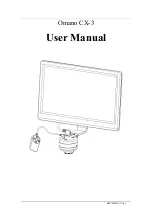
84
Next, in the “Trigger Thresholds” section, enter the absolute and relative transient levels you wish to
trigger on. Care must be taken in choosing this level.
A perfect sine wave has a peak instantaneous value of its RMS level times the square root of two. For
instance, the normal peak instantaneous voltage of a 120Vrms circuit is 120x1.414= 170V. This
means that a perfect 120Vrms sine wave will reach +170V and -170V once during each cycle. A sine
wave that is less than perfect can be quite higher (if the crest factor is higher). For this reason we have
included a helpful aide in determining the absolute threshold for a given circuit. Click on the icon to the
right of the box in which you enter the absolute trigger threshold.
The “Calculation of Instantaneous”
dialogue
box will open. Enter the largest normal RMS value you expect to see in the “RMS Input” box.
A recommended setting for the absolute transient level will appear in the “Abs Instantaneous” box. This
level is about 10% above the normal peak of a pure sine wave of the RMS level entered. For instance,
if you enter 120Vrms, the recommended absolute transient threshold will be 186.6 volts. Whenever the
voltage rises above +186.6 volts or drops below -186.6 volts for longer than 8 usec, an absolute trigger
will occur and it will last until the instantaneous value drops to slightly less than 186.6 volts and stays
less than 186.6 volts for the remainder of the cycle.
Similarly, we have included a helpful aide in determining the relative threshold for a given circuit. Click
on the icon to the right of the box in which you enter the relative trigger threshold. The “Calculation of
Instantaneous” dialogue box will open. Enter the largest normal RMS value you expect to see in the
“RMS Input” box. A recommended setting for the relative transient level will appear in the “Rel
Instantaneous” box. This level is about 20% of the normal peak of a pure sine wave of the RMS level
entered. For instance, if you enter 120Vrms, the recommended relative transient threshold will be 30
volts. Whenever the voltage that is independent from the underlying periodic waveform rises or falls at
least 30 volts for longer than 8 µsec, a relative trigger will occur and it will last until the instantaneous
value drops to slightly below 30 volts and stays below that for the remainder of the cycle.
It should be noted that you generally will not want to select the neutral current, I
N
, if you are also
triggering on other currents. This is because the neutral current is typically much smaller than the other
phase currents and needs to have different trigger thresholds.
When all the trigger levels are set correctly, you may save the data setup to a file or to a connected
ATPOL II.
Receiving Transient Data from ATPOL II
To receive transient data from ATPOL II, the ATPOL II unit must be
connected to a computer running PSM. At the main menu of PSM,
the green “Unit Connected” Status box must be displayed. Click on
the
“Receive Data” button or click on “Data” and then “Receive
Data
”. In either case, the Receive Data menu will open and all the
different types of data files in the connected ATPOL II will be
displayed.
Содержание ATPOL II
Страница 109: ...109...
















































